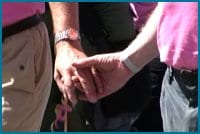The number of same-sex couples “surged” 32.6 percent from 2001 to 2006, five times the pace of opposite-sex couples, according to census information released by Statistics Canada today.
The increase is probably not a surprise to many, considering the legalization of same-sex marriage across Canada in 2005 and the growing acceptance of gays and lesbians.
Of 45,345 same-sex couples in 2006, 7,465 were married. Canada’s proportion of same-sex couples to total couples (0.6 percent) is comparable to New Zealand and Australia, Statistics Canada notes.
While the 2006 census was the first to count same-sex marriages, lobby group Egale argues the census form treated same-sex couples differently than opposite-sex couples. The form asked people in same-sex marriages not to tick off the “husband” or “wife” box, but to tick off the “other” option. Egale encouraged couples to ignore these instructions and advocates for ‘one spouse option for everybody.’
Last year, Statistics Canada admitted that the census form was out-of-date, and said that the questions were written at a time when same-sex marriage had not yet been legalized.
“The process to draw up the questions and get them approved takes a long time, three years,” André Langdon, a communications officer with Statistics Canada, told Xtra in Apr 2006.
The census also contradicts previous estimates of the actual number of married gay couples. In Nov 2006, lobby group Canadians For Equal Marriage reported that there were 12,438 married same-sex couples by the end of summer 2006. But the census data suggests that there were only 7,465 married same-sex couples in 2006.
And what was common knowledge before now has more statistical proof: most gay couples like living in big cities. More than eight out of 10 same-sex couples live in urban areas, suggests the census. More than half were living in Canada’s three largest cities, while Montreal and Vancouver reported the highest proportion of queer couples.
Same-sex couples as a percentage of all couples (by metropolitan area):
- 1.0 percent: Montreal, Vancouver
- 0.9 percent: Ottawa-Gatineau, Halifax, Moncton, Victoria
- 0.8 percent: Toronto, Québec, Kingston
- 0.7 percent: Guelph
- 0.6 percent: national average
The census also found that same-sex couples were generally younger than opposite-sex couples, and there were more male same-sex couples than female (53.7 percent versus 46.3 percent).

 Why you can trust Xtra
Why you can trust Xtra


